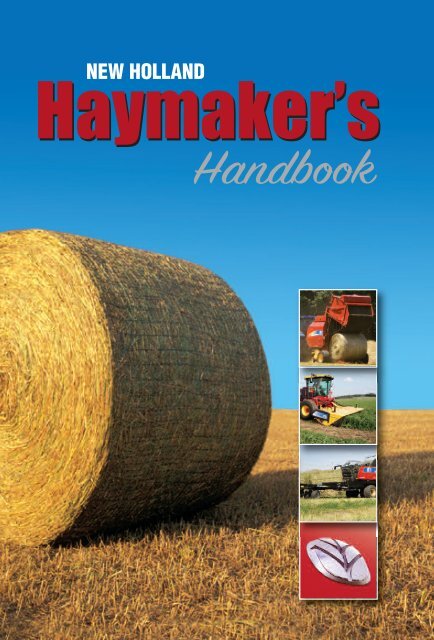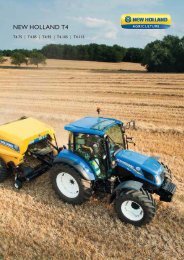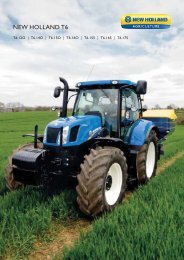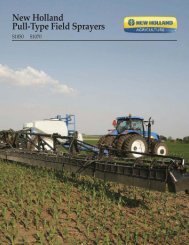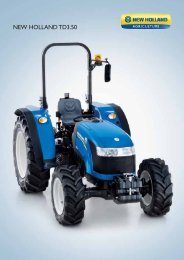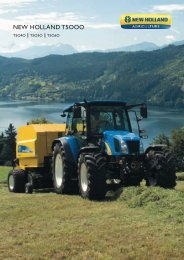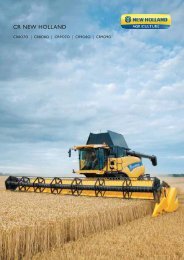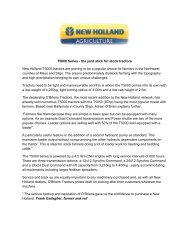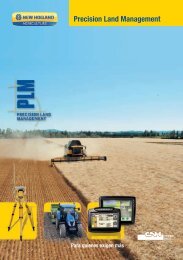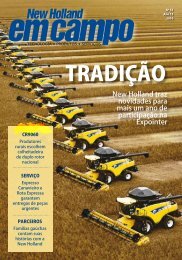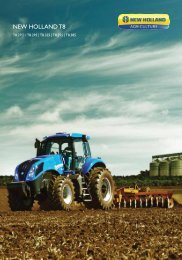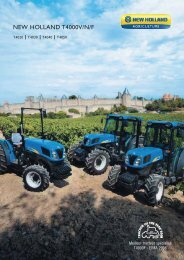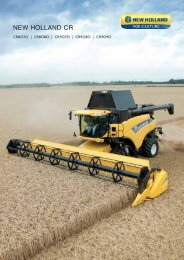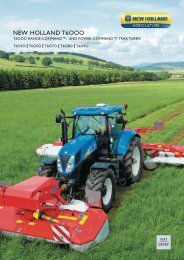You also want an ePaper? Increase the reach of your titles
YUMPU automatically turns print PDFs into web optimized ePapers that Google loves.
NEW HOLLAND<br />
Haymaker’s<br />
Haymaker’s<br />
<strong>Handbook</strong>
NEW HOLLAND<br />
Haymaker’s <strong>Handbook</strong><br />
First Edition Copyright ©1975<br />
Sperry <strong>New</strong> <strong>Holland</strong><br />
<strong>New</strong> <strong>Holland</strong>, Pennsylvania<br />
Second Edition Copyright © 1987<br />
<strong>New</strong> <strong>Holland</strong>, Inc.<br />
<strong>New</strong> <strong>Holland</strong>, Pennsylvania<br />
Michael A. Balas, <strong>New</strong> <strong>Holland</strong><br />
Marketing Communications Dept., Editor<br />
Dr. John E. Baylor, Professor Emeritus<br />
of Agronomy Extension, Penn State<br />
University, Contributing Editor<br />
Third Edition (Renewed) Copyright<br />
©2011, CNH America LLC<br />
<strong>New</strong> <strong>Holland</strong>, Pennsylvania<br />
Warren H. Erb, <strong>New</strong> <strong>Holland</strong> Marketing<br />
Training Dept. Retiree, Co-Editor<br />
Jordan Milewski, Hay & Forage Marketing,<br />
<strong>New</strong> <strong>Holland</strong> Agriculture, Co-Editor<br />
Kenneth E. Griswold, Ph.D., Dairy Extension<br />
Educator, Penn State Cooperative<br />
Extension, Contributing Editor<br />
Paul H. Craig, Dauphin County, PA,<br />
Cooperative Extension, Contributing Editor<br />
Toby Buckley, Art Director
Dr. JOHN E. BAYLOR<br />
is Professor Emeritus of Agronomy at the<br />
Pennsylvania State University. He retired in<br />
1983 after 26 years as Extension Forage Specialist.<br />
He emphasized forge production and<br />
quality and conducted many innovative programs<br />
including a statewide Alfalfa Growers<br />
Program, in-depth forage workshops for producers<br />
and agri-industry personnel, and many<br />
educational and competitive hay and hay crop<br />
silage shows. He has been a member of the<br />
American Society of Agronomy (ASA) and<br />
Crop Science Society of America (CSSA)<br />
for over 50 years and is a Fellow of both<br />
organizations. He is also a long time member<br />
of the American Forage & Grassland Council<br />
(AFGC) having served on its board and as<br />
president. He also served as Secretary-<br />
Treasurer of AFGC from 1970 until 1987 and<br />
was editor of the council's official voice - "Forage<br />
and Grassland Progress" from 1972 until it<br />
was discontinued in 1984. Internationally he<br />
was Chairman of the Governing Board for the<br />
XIV International Grassland Congress held at<br />
the University of Kentucky in June 1981, and<br />
served on the International Grassland Congress<br />
Continuing Committee. He was co-founder<br />
of the Forage and Grassland Foundation and<br />
served as its president. He was also co-founder<br />
of the Pennsylvania Forage and Grassland<br />
Council in 1960 and served as its first president.<br />
He has received a number of awards<br />
including AFGC's Medallion and Presidential<br />
Citation and its Distinguished Grasslander<br />
Award, along with the ASA Agronomic Extension<br />
Education Award and the Pennsylvania<br />
Agricultural Advisory Council Distinguished<br />
Service Award.<br />
Baylor authored several books including the 50<br />
year histories of AFGC (1994), PFGC (2010),<br />
and the Atlantic Seedsmen's Association<br />
(2002). He was also contributing editor to<br />
<strong>New</strong> <strong>Holland</strong>'s <strong>Haymaker's</strong> <strong>Handbook</strong>s published<br />
in 1975 and 1987.<br />
KENNETH E. GRISWOLD, Ph.D.<br />
is a Dairy Extension Educator with Penn State<br />
Cooperative Extension (PSCE) in Lancaster<br />
County, Pennsylvania. He is responsible for<br />
developing educational programs focused<br />
on increasing dairy profitability through<br />
improvement of production management areas<br />
including nutrition, forage utilization, herd<br />
management and records analysis. Raised on<br />
a 100-cow dairy in central <strong>New</strong> York State, he<br />
received his B.S. in animal science from<br />
Cornell University. After working in the dairy<br />
feed industry, he completed a M.S. in ruminant<br />
nutrition at West Virginia University and a Ph.D.<br />
in rumen microbiology at the University of<br />
Illinois. Following postdoctoral research in dairy<br />
nutrition at Ohio State University, Ken served<br />
five years at Southern Illinois University as an<br />
assistant professor of dairy management. Ken has<br />
been an author on over 50 articles in scientific<br />
and lay publications.<br />
PAUL H. CRAIG<br />
has been employed by Penn State University<br />
for 30 years, having worked in Washington,<br />
Monroe and Dauphin Counties of Pennsylvania.<br />
He works as part of a regional agronomy team<br />
with program emphasis on forage crop production,<br />
harvest and storage management. He<br />
received his BS in Agronomy from Penn State<br />
University in 1979 and his MS in Agronomy,<br />
also from Penn State, in 1987. He is a member<br />
of the Pennsylvania Forage and Grassland<br />
Council and the National Association of County<br />
Agricultural Agents. He is a Certified Crop<br />
Advisor.
Table of Contents<br />
Introduction<br />
1 Hay Is Big Business<br />
Growing<br />
2 Planning Your Hay Program<br />
3 Match Crop to Soil<br />
4 Lime – A Must for Quality Hay<br />
5 Fundamentals of Forage Fertilization<br />
6 Quality Seed, Proven Varieties, and Mixtures<br />
7 Get Stands Off to a Good Start<br />
8 Facts on Irrigating Hay Crops<br />
9 Forage Management to Maintain Stands<br />
10 Insects, Diseases and Weeds Can Spell Trouble<br />
Harvesting<br />
11 The Advantages of Cutting Hay Early<br />
12 Minimizing Hay Loss<br />
13 A Look at Hay Harvesting Equipment<br />
14 Mapping Out Haying Systems<br />
Packaging<br />
15 Large Round Bales for Hay & Silage<br />
15A Bale Silage<br />
16 Considering Grazing Systems<br />
16A Hay Crop Silage<br />
Feeding<br />
17 Hay as a Livestock Feed<br />
18 Hay and Forage Feeding Fundamentals – Dairy<br />
19 Hay and Dairy Herd Health<br />
20 Hay Feeding Fundamentals – Beef, Sheep and Horses<br />
Page<br />
5<br />
17<br />
21<br />
25<br />
34<br />
48<br />
54<br />
64<br />
69<br />
78<br />
87<br />
93<br />
103<br />
119<br />
131<br />
135<br />
138<br />
143<br />
151<br />
156<br />
165<br />
169
Throughout its 115 year history,<br />
<strong>New</strong> <strong>Holland</strong> has always pursued a goal<br />
of finding innovative ways to simplify<br />
farmers’ labors, making their lives less<br />
fatiguing, more pleasurable and more<br />
productive. From its freeze-proof engines<br />
of the early days to the world’s first automatic<br />
pickup baler of the early ‘40's to the<br />
first Haybine® mower-conditioner in the<br />
‘60's to the first Twin Rotor® combine and<br />
beyond, <strong>New</strong> <strong>Holland</strong> has reached its goal<br />
many times over.<br />
With the addition of balers and forage<br />
harvesters to the <strong>New</strong> <strong>Holland</strong> product line<br />
began a focus on hay and forage production.<br />
Since then, <strong>New</strong> <strong>Holland</strong> has cultivated<br />
a passionate interest in the crops,<br />
their regional production methods, and<br />
the machines designed to handle them.<br />
Through a complete knowledge of these<br />
crops, methods and producers, the company<br />
has excelled in creating, manufacturing<br />
and servicing the machines needed for<br />
their harvest.<br />
Early on, <strong>New</strong> <strong>Holland</strong> adopted several<br />
slogans to tie the company closely to<br />
hay and forage production in a way that<br />
went far beyond designing and building<br />
machines.<br />
Slogans like “First in Grassland Farming,”<br />
“Eat More Meat, Drink More Milk for a<br />
Healthy Agriculture,” and “Hay in a Day”<br />
became synonymous with the name<br />
<strong>New</strong> <strong>Holland</strong> and established the firm<br />
as a leader in the field.<br />
Preface<br />
At the same time, the company became<br />
deeply involved with college and university<br />
agricultural departments and was<br />
very active in The American Forage and<br />
Grassland Council. Convinced that the<br />
pursuit of quality hay and forage production<br />
as it related to equipment was an important<br />
part of its mission, <strong>New</strong> <strong>Holland</strong><br />
published a booklet in 1975 entitled<br />
Haymaker’s <strong>Handbook</strong>, a small, abbreviated<br />
“how-to” guide book drawing together<br />
relevant university research, farmer<br />
know-how and company expertise to help<br />
both novices and well established farms<br />
understand the latest techniques and to<br />
improve upon hay and forage production.<br />
This booklet was so popular that it was<br />
revised and re-printed in 1987. Since then,<br />
it has successfully guided hundreds of<br />
forward-thinking producers around the<br />
world.<br />
Although time has passed, many of the<br />
original messages contained within the<br />
early editions of Haymaker’s <strong>Handbook</strong><br />
remain valid despite the many landmark<br />
industry developments that have occurred.<br />
Today’s renaissance in quality and focus<br />
on improved varieties and yields have<br />
driven this third edition of the popular<br />
handbook. Modern hay and forage crops<br />
are distinguished as valuable farm commodities<br />
and indispensable livestock<br />
feedstuffs. In reading this latest edition,<br />
a new generation of producers may<br />
discover the knowledge of prior generations<br />
and heed today’s advanced production<br />
methods, learning to balance farm<br />
tradition with modern practices.
54<br />
CHAPTER 7<br />
Get Stands Off to a Good Start<br />
It’s no secret that if you<br />
want top forage yields you<br />
must start with good<br />
stands.<br />
If asked why your seeding<br />
failed, you may say, “poor<br />
quality seed,” “dry soil,”<br />
or perhaps “too many<br />
weeds.” All of which<br />
point to the fact that<br />
successful seedling establishment<br />
of small seeded<br />
hay crops is governed by<br />
many factors – quality<br />
seed, proper seedbed, adequate<br />
lime and fertilizer,<br />
seeding at the right time,<br />
the best crop sequence,<br />
good seeding techniques,<br />
and satisfactory control of<br />
troublesome weeds and<br />
insects.<br />
Moisture, Temperature,<br />
and Light<br />
Other factors are important, too.<br />
Forage seeds require moisture, oxygen<br />
and some warmth to germinate and<br />
grow. The seeds are small and must<br />
be planted close to the soil surface.<br />
One-quarter to three-eighths-inch<br />
planting depths are optimum under<br />
most conditions.<br />
Too much or too little water may harm<br />
the seeds and seedlings. In wet soils,<br />
oxygen may be lacking while temperatures<br />
may be too cool for germination<br />
and seedling growth. Then, too, some<br />
seeds can absorb water and start to<br />
Growing<br />
Successful seedling establishment of small seeded hay crops<br />
is governed by many factors – quality seed, proper seedbed,<br />
adequate lime and fertilizer, seeding at the right time, the<br />
best crop sequence, good seeding techniques, and satisfactory<br />
control of troublesome weeds and insects.<br />
germinate in soils too dry for survival<br />
of small seedlings.<br />
Light, both intensity and day length,<br />
has a big influence on the early development<br />
of forage plants. Reduced light<br />
intensities, due either to excessive<br />
cloudiness or competition from crops<br />
or weeds, may be responsible for many<br />
seeding failures of both legumes and<br />
grasses.<br />
Greenhouse studies at Penn State<br />
University show how important light<br />
is. Under controlled conditions, top<br />
growth of bird’s-foot trefoil was<br />
reduced about 90% by reduced light
intensities due to shading. Root growth<br />
was affected more severely than top<br />
growth.<br />
Plants growing together may shade<br />
one another to almost the same degree.<br />
Under the dense stand of an oats<br />
crop, for example, light levels may be<br />
reduced by 95% or more. Such levels<br />
may be too low for the seedling to<br />
survive.<br />
Some forage seedlings are more shade<br />
tolerant than others. But three words,<br />
“legumes like light,” pretty well tell<br />
the story, regardless of species or<br />
variety.<br />
We talk a lot about competition, but<br />
other factors may be working, too, one<br />
of which is called allelopathy. Allelopathy<br />
is any direct or indirect<br />
harmful effect by one plant or another<br />
through the production of chemical<br />
compounds that escape into the environment.<br />
A very important point concerning<br />
allelopathy or autotoxicity is<br />
that its effect depends on a chemical<br />
being added to the environment, thus<br />
separating it from the competition effects<br />
noted earlier.<br />
While not all researchers agree, there is<br />
plenty of evidence to suggest that<br />
alfalfa yields and stand densities are<br />
FIGURE 7-1<br />
greater when alfalfa is rotated with<br />
soybeans, corn, or grasses, compared<br />
to growing alfalfa after alfalfa. This is<br />
supported by the research shown in<br />
Figure 7-1.<br />
The University of Illinois concludes<br />
that there is a problem when alfalfa is<br />
seeded directly back into an old alfalfa<br />
stand, especially if the old stand is<br />
around 50% or more alfalfa.<br />
How Many Plants per Acre?<br />
Plant populations and hay yields usually<br />
decline as stands get older, especially<br />
with legumes. So what makes a productive<br />
forage stand? That may depend on<br />
where you farm, the crop you grow, and<br />
the age of stand. For example, in South<br />
Dakota, specialists consider 300,000<br />
legume plants per acre (7 plants per<br />
square foot) as nearly ideal under most<br />
conditions in that area. A field with<br />
300,000 plants per acre would produce<br />
as much hay in a drought year as a field<br />
with 150,000 plants, they report, but<br />
would yield more in a favorable season.<br />
In North Dakota studies, alfalfa hay<br />
yields in the establishment year increased<br />
with increasing plant density, up<br />
to a point, but by the second production<br />
year, yields began to level out. Workers<br />
in that state concluded that under their<br />
growing conditions, near maximum<br />
The Effects of Various Crop Sequences on Alfalfa Yields and<br />
Stand Count after 6 Years (Illinois data)<br />
Alfalfa Yield Plant Per<br />
Cropping Sequence Tons DM/Acre Square Foot<br />
Corn - alfalfa 3.8 4.6<br />
Corn - soybeans - alfalfa 3.5 3.8<br />
Alfalfa<br />
Sources: University of Illinois<br />
1.9 2.0<br />
55
56<br />
alfalfa yields can be produced with<br />
seeding rates that establish ten evenly<br />
distributed plants per square foot by<br />
the fall of the seeding year. Most<br />
researchers suggest a decline in alfalfa<br />
stand density has little direct effect on<br />
forage quality.<br />
Minnesota authorities point out that<br />
just one pound of alfalfa seed per acre<br />
equals five seeds per square foot. Sow<br />
eight pounds of alfalfa and six pounds<br />
of bromegrass and you have 58 plants<br />
per square foot – if every seed germinated.<br />
Everything considered, a good rule of<br />
thumb rule for legumes is about<br />
500,000 strong seedlings per acre, or<br />
twelve plants per square foot. Somewhat<br />
more grass seedlings per square<br />
foot, especially for bunch grasses, may<br />
be desirable.<br />
But you’ll generally need to sow more<br />
seeds per acre to assure a good stand.<br />
It’s not unusual for legume populations<br />
to drop to only five to ten plants per<br />
square foot within a short time after<br />
seeding. And, as plants reach full size,<br />
natural competition thins them out<br />
even more.<br />
Thus, don’t skimp on seed. But don’t<br />
be extravagant either. Check on seeding<br />
rate recommendations with local<br />
authorities and be sure you’re planting<br />
the right amount of seed to end up with<br />
high producing stands.<br />
Remember, too, that seeding rate is<br />
related to seeding method. With precision<br />
seeding techniques and no-till<br />
seedings, for example, rates can safely<br />
be reduced by 15%-20% compared to<br />
broadcasting.<br />
FIGURE 7-2<br />
The Approximate Seeds Per Pound of Several Forage Crop Species<br />
Together with the Theoretical Number of Seeds Per Square Foot<br />
at Various Rates<br />
Approximate<br />
Seeds/Square Foot at<br />
Seeding rate per acre of<br />
Crop Seeds/Pound 1 lb. 2 lb. 5 lb. 10 lb.<br />
Alfalfa 221,000 5 10 26 51<br />
Bluegrass, Kentucky 2,000,000 46 92 230 460<br />
Brome, Smooth 137,000 3 6 16 31<br />
Clover, Ladino 754,000 17 35 87 173<br />
Clover, Red 293,000 7 13 34 67<br />
Crown vetch 120,000 3 6 14 27<br />
Fescue, Tall 246,000 6 11 28 56<br />
Orchard grass 468,000 11 21 54 107<br />
Redtop 5,605,000 129 257 644 1287<br />
Reed Canary grass 660,000 15 30 61 152<br />
Ryegrass 280,000 6 13 32 64<br />
Sudangrass 55,000 1 3 7 13<br />
Timothy 1,260,000 29 58 145 289<br />
Trefoil, Bird’s-foot 414,000 10 19 48 95
But, regardless of your intended seed<br />
rate or seeding technique, remember to<br />
calibrate your seeder before going into<br />
the field. Intended seeding rates and/or<br />
seeding depths are often quite different<br />
from what is actually done because the<br />
equipment is not properly adjusted or<br />
calibrated.<br />
When to Seed<br />
In some areas, it’s possible to make a<br />
successful seeding almost any month of<br />
the growing season.<br />
In general, seedings made prior to<br />
prolonged cool and moist weather are<br />
more successful than those made when<br />
it’s hot and dry.<br />
During the winter and early spring<br />
months, soil moisture has built up and<br />
spring moisture is generally good. Evaporation<br />
is less during the spring and soil<br />
moisture is retained longer during the<br />
establishment period.<br />
To take advantage of the “ideal” conditions<br />
at this season of the year, including<br />
better moisture and less competition<br />
from weeds, spring seedings of most<br />
species should be made as early as a<br />
FIGURE 7-3<br />
The Percent Seedling Emergence of Several Forage Crops<br />
When Seeded at 4 Depths.<br />
proper seedbed can be prepared. Seed<br />
alfalfa in early April without a companion<br />
crop and harvest your first hay crop<br />
in about 70 days. Exceptions to this<br />
“early as possible” rule are bird’s-foot<br />
trefoil and crown vetch, which should<br />
not be seeded until soil temperatures<br />
reach the upper 50’s.<br />
Seeding in the late summer is also<br />
popular in some areas, and is considered<br />
especially ideal for many coolseason<br />
grasses because of cool nights,<br />
adequate rainfall, and warm soil. In<br />
general, grasses sown in the late summer<br />
or early fall root more deeply<br />
because the slower top growth is<br />
conducive to better root formation.<br />
However, some grass species, such as<br />
orchard grass, are relatively nonhardy in<br />
the seedling stage, while others, such as<br />
bromegrass and reed canary grass lack<br />
seedling vigor. Thus, these species must<br />
be seeded relatively early in the season<br />
to assure good winter survival. Success<br />
is most often achieved where at least 8<br />
to 10 weeks of good growing weather<br />
precede winter dormancy.<br />
Seedling Depth in inches<br />
Crop 1/2 1 1 1/2 2<br />
Alfalfa 64 53 45 19<br />
Clover, Alsike 53 49 9 4<br />
Clover, Ladino 47 28 2 0<br />
Clover, Red 56 62 22 14<br />
Bluegrass, Kentucky 43 27 4 0<br />
Bromegrass 78 69 51 24<br />
Timothy 89 81 39 12<br />
Redtop 64 33 2 0<br />
57
58<br />
Depth of Seeding<br />
Hay legume and grass seeds are small<br />
and can easily be placed too deeply.<br />
The optimum depth for small forage<br />
seeds is one-quarter to three-eighths<br />
inch on heavy soils and one-half to<br />
three-quarters inch on light soils. These<br />
facts have been confirmed by research<br />
throughout the U.S. One look at Figure<br />
7-3 will tell you how seedlings of<br />
several crops emerged when planted<br />
at different depths.<br />
The Ideal Seedbed<br />
Firm, fine, and mellow on the surface is<br />
one way to describe the ideal forage<br />
seedbed.<br />
If the seedbed is not firm, tiny legume<br />
and grass roots will grow into air pockets<br />
between soil particles and die. That<br />
firm, fine, and mellow seedbed is also<br />
essential to permit uniform, shallow<br />
coverage of seed.<br />
For the prepared seedbed, early plowing,<br />
followed by an occasional disking<br />
A fine, firm seedbed improves chances of a successful<br />
forage stand. If the seedbed is too loose,<br />
tender legume and grass roots dry out and may<br />
die.<br />
or harrowing, will aid in firming the<br />
soil in the seeding zone. Cultipacking<br />
before seeding is additional assurance<br />
of a firm seedbed.<br />
But whatever plan you follow, a<br />
seedbed firm enough for a man to walk<br />
across without sinking more than a<br />
quarter inch into the soil is a good rule<br />
to follow.<br />
Inoculate Legumes<br />
Rutgers University scientists pointed<br />
out many years ago that every acre is<br />
“covered” with 35,000 tons of free nitrogen<br />
in the atmosphere. Out of this<br />
vast nitrogen supply, only a tiny portion<br />
is taken by legumes. However, this<br />
nitrogen can be an important factor in<br />
cutting the amount of commercial<br />
nitrogen needed for the following crop.<br />
But legumes salvage nitrogen only if<br />
efficient legume bacteria (rhizobia) are<br />
present. And as pointed out by the late<br />
Dr. O. N. Allen, rhizobiologist at the<br />
University of Wisconsin, “Only 25% of<br />
all rhizobia found naturally in the soil<br />
are highly beneficial.”<br />
Legumes and bacteria establish a working<br />
relationship called symbiosis. The<br />
plant furnishes sugar, energy, and nodules<br />
formed by bacteria. The bacteria<br />
use energy to change free nitrogen from<br />
the air into a form used by the plants.<br />
Not all soils contain nitrogen-fixing<br />
bacteria of either the right kind for a<br />
specific crop or in sufficient quantity.<br />
Rhizobia content of soils varies according<br />
to geographical area, cropping<br />
history, and the soil itself. That’s why<br />
it’s important to inoculate legume seeds<br />
and with the proper strain of bacteria.<br />
When and Why of Inoculation<br />
Under favorable conditions and a
continuous legume cropping history,<br />
the right kind and adequate amount of<br />
bacteria may be present in the soil<br />
horizon. However, in cases of low pH or<br />
low fertility, drought, high soil temperature,<br />
or persistent rains, the number of<br />
bacteria may be greatly diminished.<br />
Under such conditions, and especially<br />
when planting legumes for the first time<br />
on new land, or if four or five years<br />
have elapsed since the previous legume<br />
crop, seed definitely should be inoculated.<br />
A good rule of thumb is “when in<br />
doubt, inoculate.”<br />
Inoculation adds a fresh culture of effective<br />
rhizobia strains to seed and soil.<br />
Thus, rhizobia can begin working as the<br />
seed germinates and the plant starts<br />
growing. Since protein content in<br />
legumes is directly related to nitrogen<br />
content, effective inoculation is a major<br />
key to improving yield and quality.<br />
Benefits of Inoculation<br />
Research shows the more effective<br />
strains of legume bacteria can increase<br />
yield or protein content of legumes as<br />
much as 20%, on the average, over<br />
natural legume bacteria in the soil.<br />
Without legume bacteria in the soil,<br />
legumes can’t take nitrogen from the air.<br />
So inoculation is essential to give<br />
legumes the chance they need to reach<br />
full potential.<br />
The amount of nitrogen legumes can fix<br />
varies widely, depending on many factors.<br />
Of these factors, the five most important<br />
are: (1) type of legume, (2) how<br />
well seeds are inoculated and effectiveness<br />
of inoculating bacteria, (3) soil<br />
type and fertility level, (4) soil pH, and<br />
(5) climatic conditions.<br />
When conditions are favorable, a<br />
stand of alfalfa may fix nearly 200<br />
pounds of nitrogen per acre. On the<br />
other hand, annual legumes such as<br />
soybeans will fix about 40 to 60<br />
pounds.<br />
Pre-inoculation<br />
Seed can be hand inoculated with a<br />
fresh culture of the proper strain of<br />
bacteria just prior to sowing. However,<br />
much of the alfalfa and clover<br />
seed currently marketed is already<br />
pre-inoculated with the proper<br />
strain. <strong>New</strong>er pre-inoculated techniques,<br />
such as the clay-based Dormal<br />
process, have proven highly<br />
effective and have extended the<br />
shelf life over conventional humusbased<br />
pre-inoculants. Nevertheless,<br />
pre-inoculated seed carried over<br />
from spring for summer or fall<br />
seedlings should normally be<br />
reinoculated prior to seeding.<br />
Seed Treatments<br />
Other newer seed treatments are<br />
also available to help get new seedings<br />
off to a good start. Studies in<br />
several states have shown that treating<br />
seed of several species with the<br />
systemic fungicide metalaxyl, marketed<br />
under the trade name Apron,<br />
provides good protection against<br />
present strains of the pythium and<br />
phytophthora seed and root-rot<br />
organisms. Treated seed lots<br />
frequently resulted in initial stands<br />
20% to 40% better than untreated<br />
controls. Based on current information,<br />
Apron can be used successfully<br />
with both clay-based and humusbased<br />
pre-inoculants if directions<br />
59
60<br />
are followed carefully.<br />
Lime coating of legume seeds has also<br />
been accepted in some states as an aid<br />
to better stands. <strong>New</strong>er lime coating<br />
processes seem to work well with both<br />
pre-inoculated and Apron treated seed.<br />
Seeding Tools<br />
Good hay-crop stands can be obtained by<br />
using a variety of techniques. Some are<br />
more successful than others, depending on<br />
local soil and climatic conditions.<br />
Seeding equipment commonly used for<br />
grasses and legumes on a prepared<br />
seedbed include:<br />
(1) Cultipacker Seeder. This machine<br />
works well for seeding legumes or smallseeded<br />
grasses on areas free of crop<br />
residue. Light-weight seeds – smooth<br />
bromegrass or wheatgrass – may not be<br />
well covered and smaller seeds may not<br />
be covered with the cultipacker seeder on<br />
areas having heavy crop residues.<br />
(2) Press Drill. A drill which has press<br />
wheels following the seed tubes is best on<br />
fields with crop residue. A press drill also<br />
shows excellent results on plowed or<br />
DISC<br />
SOIL SURFACE<br />
Band Seeding Most Reliable<br />
FERTILIZER<br />
PLACEMENT<br />
SEED TUBE<br />
WHEEL<br />
PACKER<br />
SEED<br />
PLACEMENT PACKING<br />
FERTILIZER<br />
clean, fallowed land if a uniform<br />
shallow seeding is made. They warn<br />
that lightweight grass seeds may<br />
“bridge over” in the drill box and not<br />
feed down the spouts.<br />
(3) Grain Drill. On plowed or clean,<br />
fallowed land, a grain drill can be<br />
used without press wheels. Pack the<br />
field after seeding, but remember that<br />
packing can lead to erosion, under<br />
some conditions. “Bridging over” is<br />
also a problem.<br />
(4) Broadcast Seeder. A broadcaster<br />
can be used for seeding forage<br />
legumes on plowed or clean fallowed<br />
land if seed is harrowed in, or gone<br />
over with a corrugated roller. In<br />
some areas, early spring broadcasting<br />
without covering is the accepted<br />
method for seeding red clover in fallsown<br />
wheat.<br />
Fluid or suspension seeding is a relatively<br />
new, but very effective, custom<br />
way of broadcasting seed uniformly<br />
over large acreages in a short time.<br />
However, cultipacking before and<br />
after seeding is a must with this type<br />
of seeding. Authorities generally<br />
agree that if seeding occurs immediately<br />
after the inoculated seeds are<br />
added to the suspension, there’s no<br />
injury to the rhizobia.<br />
No-Till Seedings Gaining Favor<br />
In many areas, seeding alfalfa or<br />
other legumes the no-till way either<br />
in small grain or corn stubble, or in<br />
sod, has gained momentum in recent<br />
years.<br />
Several requirements for successful<br />
no-till establishment include:<br />
(1) Competition from other plants
must be eliminated.<br />
(2) Heavy thatch and plant growth tall<br />
enough to shade the soil surface must<br />
be removed.<br />
(3) Protect the seedlings from insects,<br />
especially when seeding in sod.<br />
(4) Soil fertility must be medium to<br />
high with pH about 6.5.<br />
(5) Seed at the proper time.<br />
(6) Use proper, well maintained<br />
equipment.<br />
Seeding Forages with a<br />
Companion Crop<br />
Small grain companion crops are<br />
among the oldest methods of getting<br />
weed-free forage the seeding year.<br />
However, recent research shows small<br />
grain crops compete with young<br />
seedlings for light, moisture, and nutrients.<br />
Where oats or other spring grains are<br />
used as a companion crop, all forage<br />
experts advise using a variety that is<br />
short, early maturing, stiff-strawed,<br />
and non-lodging. Then reduce its seeding<br />
rate by one-half. Lodging resistance<br />
is of greatest importance. Many<br />
seedings are thinned or lost when<br />
lodged grain forms a tight canopy over<br />
the legume, sealing out light. Barley is<br />
especially susceptible to lodging and<br />
is not usually recommended as a companion<br />
crop. For best results where<br />
oats is used, remove as green chop,<br />
silage, or hay, just as the heads emerge<br />
from the boot. After harvesting oats,<br />
close clipping of stubble can markedly<br />
improve the legume seeding. Careful<br />
management after the oat crop is removed<br />
is also important. Red clover<br />
can be improved more than alfalfa by<br />
clipping. Trash should be removed<br />
from fields after clipping. Delaying<br />
clipping until late August is beneficial<br />
only if you have good rainfall<br />
and soil moisture.<br />
Weeds develop quickly in unclipped<br />
fields. Heavy weed growth almost<br />
always reduces vigor and density of<br />
new legume stands, as well as reducing<br />
hay yields the following spring.<br />
Ohio tests indicate stands usually are<br />
better when alfalfa is seeded in oats<br />
instead of in wheat. But for fall<br />
seeding, wheat is better than barley<br />
or rye. Wheat is sometimes superior<br />
to oats as a companion crop for red<br />
clover.<br />
Eliminate That Companion<br />
Crop<br />
Recently many hay growers<br />
throughout the country have turned<br />
to spring seedings without a grain<br />
crop, especially with legumes.<br />
Except where weeds have been a<br />
serious problem, this practice has<br />
meant from 4 to 5 or more tons the<br />
seeding year.<br />
Researchers in Illinois, Michigan,<br />
Iowa, and Ontario found proper<br />
herbicides applied when alfalfa is a<br />
few inches high do a good job of<br />
controlling broadleaf weeds. This<br />
gets legumes off to a good start,<br />
eliminates the need for a companion<br />
crop, and gives 4 or more tons of<br />
top-quality forage the seeding year.<br />
Forage stands established without<br />
companion crops are usually better<br />
and more productive in following<br />
61
62<br />
years. When legumes are seeded<br />
without a companion crop, weeds<br />
are a problem and some means of<br />
control is necessary.<br />
Good Weed Control Critical<br />
Thus, good weed control with herbicides<br />
at establishment is critical to<br />
getting good hay stands.<br />
Herbicides used for hay stand establishment<br />
can generally be classified<br />
as either pre-plant or post-emergence<br />
materials.<br />
EPIC and benefin are pre-plant<br />
incorporated herbicides. That is, they<br />
are applied before planting and incorporated<br />
within the soil to a depth of<br />
1 to 2 inches. If used at the proper<br />
rate and thoroughly mixed with the<br />
soil, these herbicides will control<br />
most of the annual grasses and<br />
many broadleaf weeds found in new<br />
legume seedings. Eptam also does an<br />
excellent job of controlling nutsedge.<br />
Since these herbicides will severely<br />
injure seedling forage grasses, weed<br />
specialists stress they cannot be used<br />
in mixtures with forage grasses.<br />
Where grass-legume mixtures are to<br />
be made, you must rely on a spot<br />
emergence application of 2,4-DB<br />
for control of the broadleaf weeds<br />
but the grass weeds will be missed.<br />
However, for effective control, these<br />
materials must be applied when the<br />
weeds are small and the forage<br />
legumes are in the second to third<br />
trifoliate leaf stage.<br />
Weed authorities further emphasize<br />
that forage legumes differ in their<br />
susceptibility to many of the herbi-<br />
cides mentioned. Alfalfa and bird’sfoot<br />
trefoil, for example, are tolerant<br />
to treatments of EPIC, benefin, and<br />
2,4-DB, but sweet clover and crown<br />
vetch are susceptible.<br />
Before using herbicides on new<br />
seedings, be sure to check with<br />
local authorities for specific<br />
recommendations.<br />
One final word: many new seedings<br />
have been severely damaged from<br />
herbicide residues, particularly triazines.<br />
Thus, plan your herbicide<br />
program for all of the crops in the rotation,<br />
not just the immediate seeding.<br />
Manage Those <strong>New</strong> Seedings<br />
Seeding year management can be<br />
important to the successful establishment<br />
of a new seeding, too. This<br />
includes insect control.<br />
One excellent approach to a successful<br />
spring seeding is to seed on a<br />
prepared seedbed, eliminate the<br />
companion crop, control weeds and<br />
insects with chemicals, and remove<br />
the first hay crop the seeding year<br />
when the legume reaches the late<br />
bud to early bloom stage of growth.<br />
Normally with this program, three or<br />
more harvests may be made the year<br />
of seeding, depending on the length<br />
of the growing season.<br />
In many areas of the U.S., potato<br />
leafhoppers can be very destructive<br />
on new spring seedings of alfalfa and<br />
other legumes. If leafhopper populations<br />
build up, there are several<br />
approved insecticides available to<br />
effectively control this pest on new<br />
seedings. However, daily inspections<br />
of the fields are necessary to detect
its presence.<br />
When weeds are a problem in spring<br />
seedings made without a companion<br />
crop, wait until the alfalfa is at the<br />
proper stage, second trifoliate, and<br />
apply post-emerge herbicides for<br />
best controls.<br />
Establishing Bermuda Grass<br />
Bermuda grass and other vegetatively<br />
propagated species require<br />
special attention for establishing<br />
stands. When preparing a seedbed,<br />
two factors are important: (1) sprigs<br />
(portion of stem or root used for<br />
transplanting) should be planted only<br />
in moist soil, and (2) the seedbed<br />
should be weed-free or weeds controlled<br />
immediately with herbicides<br />
after planting.<br />
Planting should be fairly deep to insure<br />
continued soil moisture, but tops<br />
should be above ground. However,<br />
planting too deep may delay emergence<br />
and seems to increase spring<br />
damage by soil microbes.<br />
Fertilizing as soon as stolons appear<br />
will help to hasten development<br />
and ground cover.<br />
More Bermuda grass is propagated<br />
by planting sprigs than by seeding.<br />
Farmers generally have better success<br />
with this method. Poor seeding<br />
habits of coastal hybrid forage<br />
varieties such as Midland and<br />
Teft-44 types make it mandatory<br />
they be established from sprigs.<br />
Some farmers maintain on-farm<br />
Bermuda grass nurseries to insure<br />
having fresh planting material<br />
available.<br />
Bermuda grass specialists say there<br />
are three major reasons for stand<br />
failures: (1) planting on areas that<br />
have stands of other grasses, (2)<br />
using dried out sprigs, and (3)<br />
grazing before grass is established.<br />
They suggest planting sprigs on a<br />
clean, moist seedbed free of other<br />
growing grasses. Use fresh sprigs<br />
with at least 3 nodes or joints. Plant<br />
sprigs the same day they are dug,<br />
or better still, the same half day. If<br />
not planted almost immediately,<br />
63
To purchase additional copies of<br />
Haymaker’s <strong>Handbook</strong> please contact<br />
your local <strong>New</strong> <strong>Holland</strong> dealer or visit<br />
www.newholland.com/na/haymakershandbook
$14.95<br />
<strong>New</strong> <strong>Holland</strong> Haymaker’s <strong>Handbook</strong> 2011ed. NH36145160 • SG • 2117.5


